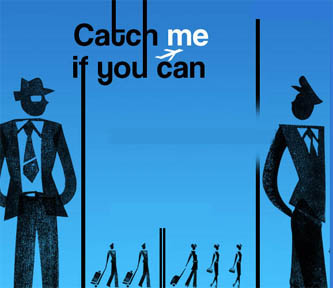Catch Me If You Can - Opening Sequence Analysis
 |
| The cartoonish style is evident from this screenshot. |
Catch Me If You Can sports an impressive title sequence full
of beautiful animations that wholly capture the imagination and theme of the
movie. What really makes this title sequence memorable is the way its subtly
suggests some of the films key themes without making it obvious.
The fonts used for the title cards are simple yet effective. They are soft and smooth and the animated characters are exaggerated and over-the-top. However, like most films, the positioning of the names and the order in which they appear, suggest greatly the importance of said person.
The fonts used for the title cards are simple yet effective. They are soft and smooth and the animated characters are exaggerated and over-the-top. However, like most films, the positioning of the names and the order in which they appear, suggest greatly the importance of said person.
From analysing Catch Me If You Can’s title sequence I have
learned that I can make my title sequence cartoonish and, if I do it well, I can still capture
and maintain what makes a thiller title sequence.
However I am not going to implement much of the conventions used in this title sequence into mine but I believe looking at this title sequence has still been beneficial to me as I am more familiar with different title sequences in the genre of thriller.
Also the cost of producing such a title sequence would be exponential as the amount of hours necessary to animate such a breath-taking piece of animation would be ridiculous. But I maintain the belief that an animated title sequence can be just as effective of showcasing a thriller movie as, lets say, the opening to Fight Club or Se7en.
Camera:
The camera used in this opening sequence does not exist in our physical world, the camera is within a computer animation software, however both work similarly. Many techniques are used to effectively transition from one shot to the next but the ones I noticed that are used more frequently are standard zoom and pan. These are used to show the simplistic nature which is clearly trying to be put across by Steven Spielberg in this opening title sequence.
Sound:
The opening portion to the opening sequence contains light hearted and soft instruments. Such as slow guitar riffs and soft piano notes. These are effective at calming the audience which could be argued is not the intention of Thriller films. However this is how Catch Me If You Can is different to most thriller films, it does not rely on dark lighting or scary music to be an effective thriller.
Then as the opening begins to come to an end the music changes to a more dark and ominous tone. The change is subtle and effective and completely changes the atmosphere. Perhaps the director chose to change the tone of the music to remind the audience they are about to watch a thriller film and not an upbear childrens comedy.
The opening portion to the opening sequence contains light hearted and soft instruments. Such as slow guitar riffs and soft piano notes. These are effective at calming the audience which could be argued is not the intention of Thriller films. However this is how Catch Me If You Can is different to most thriller films, it does not rely on dark lighting or scary music to be an effective thriller.
Then as the opening begins to come to an end the music changes to a more dark and ominous tone. The change is subtle and effective and completely changes the atmosphere. Perhaps the director chose to change the tone of the music to remind the audience they are about to watch a thriller film and not an upbear childrens comedy.
Editing:
Editing is used throughout the duration of the opening sequence to suggest urgency through the use of quick cuts. It could be argued that the director chose to do this because the urgent nature in which the shots are put together is a key convention throughout the film as the main theme is fraud.
Mise-En-Scene:
Dreamworks Pictues Presents
A Parkes/MacDonald Production
A Steven Spielberg Film
Leonardo DiCaprio
Tom Hanks
Catch Me If You Can
Christopher Walken
Martin Sheen
Nathalie Baye
Amy Adams
James Brolin
Brian Howe
Frank John Hughes
Steven Eastin
Chris Ellis
John Finn
Casting By Debra Zane, CSA
Co-Producer Devorah Moos-Hankin
Based Upon The Book By Frank W. Abagnale With Stan Redding
Titles By Kuntzel Deygas
Music By John Williams
Costume Designer Mary Zophres
Film Editor Michael Kahn, A.C.E.
Production Designer Jeannine Oppewall
Director Of Photography Janusz Kaminski, ASC
Co-Executive Producer Daniel Lupi
Executive Producers Barry Kemp, Laurie MacDonald
Executuve Producers Michel Shane, Tony Romano
Produced By Steven Spielberg, Walter F. Parkes
Screenplay By Jeff Nathanson
Screenplay By Jeff Nathanson
Directed By Steven Speilberg

